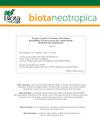Fishes of the Mitú Region: middle basin of the río Vaupés, Colombian Amazon
IF 1
4区 环境科学与生态学
Q3 BIODIVERSITY CONSERVATION
引用次数: 2
Abstract
Abstract: The Amazon River basin hosts the most diverse freshwater ichthyofauna in the world, and yet huge areas of the basin remain unexplored. This is the case for the upper tributaries of the rio Negro, especially those draining the Colombian territory. Here we present a list of 224 species derived from the examination of specimens collected in the Mitú region (Vaupés Department, Colombia), the middle basin of the río Vaupés. Of the species identified in our study, 10 species are recorded from Colombia for the first time, and 26 species are newly recorded from the Colombian Amazon. The number of species we present here comprise almost one-third of the known species diversity of the Colombian Amazon and nearly a tenth of the total number of those known across the entirety of the Amazon basin. The most diverse orders were Characiformes (120 species) and Siluriformes (65 species), and the remaining six orders comprised less than 20% of total species. The study area comprised blackwater systems, which are considered to be nutrient-poor environments. We discuss some ecological aspects that might explain how this highly diverse ichthyofauna originates and is maintain in less productive systems. The list presented here adds an important number of new records and complements the information derived from previous studies, carried out thus far with regards to the fish fauna of the Colombian Amazon.Mitú地区的鱼类:río vaupsamas中部盆地,哥伦比亚亚马逊河
摘要:亚马逊河流域拥有世界上最多样化的淡水鱼类,但该流域仍有大片地区未被开发。内格罗河上游的支流就是这种情况,尤其是那些流经哥伦比亚领土的支流。在这里,我们提出了一份来自río vaupsamas中部盆地Mitú地区(哥伦比亚vaupsamas部)采集标本的224种清单。在我们的研究中发现的物种中,有10种是首次在哥伦比亚记录的,26种是在哥伦比亚亚马逊地区新记录的。我们在这里展示的物种数量几乎占哥伦比亚亚马逊地区已知物种多样性的三分之一,占整个亚马逊盆地已知物种总数的近十分之一。特征目(120种)和志留形目(65种)种类最多,其余6目占总种数不到20%。研究区域包括黑水系统,被认为是营养贫乏的环境。我们讨论了一些可能解释这种高度多样化的鱼系如何在低生产力系统中起源和维持的生态方面。这里提出的清单增加了一些重要的新记录,并补充了迄今为止对哥伦比亚亚马逊河的鱼类动物群进行的先前研究所得的信息。
本文章由计算机程序翻译,如有差异,请以英文原文为准。
求助全文
约1分钟内获得全文
求助全文
来源期刊

Biota Neotropica
BIODIVERSITY CONSERVATION-
CiteScore
2.90
自引率
16.70%
发文量
0
审稿时长
4-8 weeks
期刊介绍:
BIOTA NEOTROPICA is an electronic, peer-reviewed journal edited by the Program BIOTA/FAPESP: The Virtual Institute of Biodiversity. This journal"s aim is to disseminate the results of original research work, associated or not to the program, concerned with characterization, conservation and sustainable use of biodiversity within the Neotropical region.
Manuscripts are considered on the understanding that their content has not appeared, or will not be submitted, elsewhere in substantially the same form, because once published their copyrights are transferred to BIOTA NEOTROPICA as established in the Copyright Transfer Agreement signed by the author(s).
 求助内容:
求助内容: 应助结果提醒方式:
应助结果提醒方式:


